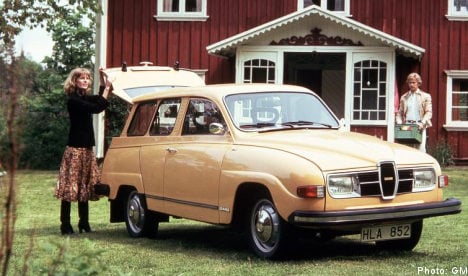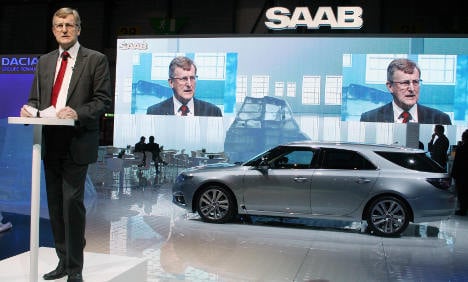Compare this to BMW, which produced 1.2 million cars in the same period or even local competitor Volvo, which sold 374,000 new vehicles. Saab is not even profitable; while most companies have suffered in the recession, Saab failed even to make a profit in the good times, and has only moved into the black once in the past twenty years.
But Saab has enjoyed brighter days. The company built its reputation on safety – in 1958 it became the first carmaker anywhere to fit seatbelts as standard and in 1972 produced the first cars with side-impact protection.
Svenska Aeroplan Aktiebolaget (‘the Swedish Airplane Company’) was founded as a plane maker back in 1937. Production of Saab cars began in 1949, with the launch of the Saab 92. Saabs were built to be aerodynamic, something that seemed obvious to the company’s aeronautical engineers, but which many larger manufacturers placed low on their lists of priorities. The cars were front-wheel drive, something else which was unusual at the time.
If the cars themselves were sensible, they were imbued with a certain sex appeal thanks to their success on the international rally circuit. Erik Carlsson became a Saab legend in the sixties after winning both the Monte Carlo and RAC rallies.
Saab merged with truckmaker Scania in 1969, giving the company certain economies of scale. The launch of the Saab 99, larger than any previous Saabs, saw the company move into the modern era of car making.
The 1980s turned out to be Saab’s glory years. The 900 was followed by the 9000, which gave the company a well-deserved place in the premium car market. Then a cabriolet version of the 900 gave Saab something it had never previously achieved: glamour.
But the boom years could not last. The 1987 stock market crash hit Saab particularly hard – unlike the larger carmakers; it did not have the strength to ride out the storm and had no new models in the pipeline. In 1990, GM took a 50 percent stake in Saab, and the two companies starting collaborating on new models. In 2000, GM bought the company outright, breaking the link with Scania.
GM tried to bring Saab back into profitability. New models were brought in and Saab started to share model platforms and manufacturing facilities with other GM brands.
The initial results of the GM partnership seemed promising – in 1995, the year after the launch of the new 900, Saab turned its first profit for seven years.
Saab’s Jan-Åke Jonsson said being part of GM brought significant advantages:
“Overall, GM has brought a lot of technology into Saab – machinery, equipment and laboratories. We’ve also benefited from being a part of a global purchaser,” he said this autumn.
But these synergies did not bring long-term profitability: the company fell back into the red in 1996 and has remained loss-making ever since, although Saab has always argued that the company was so fully integrated into GM that its official profits did not reflect the true state of the company.
Where GM has faced most criticism is in its treatment of the brand.
“GM is sometimes described as one of the industry’s worst brand-wreckers, They don’t even dare to put their own Chevrolet brand on their Corvette models,” said Mikael Wickelgren, a car industry expert at the University of Gothenburg.
Many Saab fans would agree. Tony Damström, chairman of the Stockholm Saab Owners Club, reckoned GM’s ownership had constrained Saab:
“I’ve always felt it was rather limiting, and prevented the company from finding its own innovative solutions. They’ve had to force everything into another company’s mould.”
One thing that irritated many Saab fans was GM’s propensity to slap Saab badges on cars with very un-Swedish backgrounds. One such car was the Saab 9-2X, which was a modified Subaru Impreza launched in the early-2000s, built in Japan and sold on the American market.
“I don’t think that was a good move – if a car is not a unique product, then it harms the brand. Using a common platform is one thing, but here they went too far,” said Damström.
Saab’s Jan-Åke Jonsson admitted that GM “didn’t focus so much on branding. We’ve missed opportunities in that regard.” He also says having to adjust its range to fit in with other GM brands led to the company having a “narrow offer and a long product cycle.”
When Koenigsegg entered the frame, fans hoped Saab might be able to rediscover its roots.
But what makes a Swedish car? The fate of Saab has always been inextricably linked to that of its somewhat larger compatriot, Volvo, based in Gothenburg, less than 60 miles from Trollhättan.
The identities of Saab and Volvo have always oozed Swedishness. The sturdiness of the cars, their focus on safety and latterly their environmental credentials have reflected Swedish Lutheran values of reliability, rationalism and social responsibility. In a Swedish car, sportiness and speed would never come before safety and reliability. The cars were built for tough Swedish driving conditions – they had to be able to cope with snow, dirt tracks, and the ever-present risk of crashing into a moose.
The similarities between Saab and Volvo, as well as their geographical proximity, have led to periodic calls from Swedish business and union leaders for the two to merge – in 1977, merger talks reached an advanced stage. The idea re-emerged in 2008 as Ford and GM faced financial problems. Swedish union bosses publicly backed a merger, but at the corporate level the idea was seen as unrealistic.
Now, the company’s very existence is deemed unrealistic by a slew of observers. And Saab’s fate could be sealed for good when GM meets to discuss the firm’s future at the start of December.




 Please whitelist us to continue reading.
Please whitelist us to continue reading.
Member comments